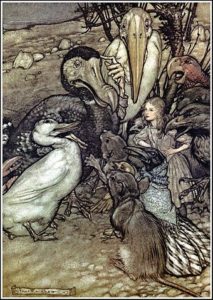Another Brick in the Wall
A Task Force for the American Psychological Association said that if clinical psychology was to survive in the heyday of biological psychiatry, it had to emphasize the strength of what it had to offer, namely “a variety of psychotherapies of proven efficacy.” So it proceeded to develop criteria to identify empirically validated treatments. Yet outcome research has regularly shown over the past forty years that “when treatments intended to be therapeutic are compared, the true difference between all such treatments is zero.” This has been referred to as the “dodo bird effect,” reflecting the observation made in 1936 by Saul Rosenzweig that common factors were responsible for the efficacy of various psychotherapies. Barry Duncan remarked: “the task force not unlike the pigs in George Orwell’s Animal Farm, continues to assert that some therapies are more equal than others.”
The APA Task Force on Promotion and Dissemination of Psychological Procedures noted that treatment manuals have become a required element of psychosocial treatment research. The standardization in treatment manuals reduces the methodological problems caused by “variable therapist outcomes.” Since no treatment will work for all problems, “it is essential to verify which treatments work for which types of problems.” Following this rationale, the Task Force suggested criteria for Empirically Validated Treatments (EVT) for two categories: Well-Established Treatments and Probably Efficacious Treatments.” You can see the criteria for each in Tables 1 and 2 in the above link.
In “The Legacy of Saul Rosenzweig: The Profundity of the Dodo Bird,” Duncan commented that although the APA had good intentions in trying to preserve a section of the therapy market for the psychology profession, “declaring an approach to be an EVT and suggesting that it should therefore be the prescribed treatment of choice is empirical bankruptcy.” The EVT approach equates the client with the problem and describes the treatment as if it is isolated from what has been shown to be the most powerful factors that contribute to therapeutic change—the client’s resources and the therapeutic relationship of client and therapist.
The EVT position virtually ignores 40 years of outcome data about common factors and the veracity of the dodo bird verdict. Model factors are pale in comparison with client and relationship factors; efficacy over placebo is not differential efficacy over other approaches.
Duncan said the EVT “house of cards” was built on the medical model of “diagnosis plus prescriptive treatment equals symptom amelioration.” He pointed back to a 1949 conference in Boulder when psychology’s training guidelines was framed with medical language and concept of mental disease. Later, when the National Institute of Mental Health (NIMH) decided to apply the same methodology it used in drug research to evaluate psychotherapy—randomized clinical trials (RCT)—it had profound effects. This methodology meant a study had to include manualized therapies (to approximate drug protocols) and DSM defined disorders to be eligible for an NIMH-sponsored research grant.
The result was that funding for studies not related to specific disorders dropped nearly 200% from the late 1980s to 1990. “Force fitting the RCT on psychotherapy research is empirical tyranny and bereft of scientific reasoning.” It takes what is a human relational method of change and tries to cram it into a series of operationally defined behavior modifications.
The RCT compares the effects of a drug (an active compound) with a placebo (a therapeutically inert or inactive substance) for a specific illness. The basic assumption of the RCT is that the active (unique) ingredients of different drugs (or psychotherapies) will produce different effects with different disorders. The field has already been there and done that—the dodo bird verdict is a reality, and the active ingredients model (or drug metaphor) borrowed from medicine does not fit.
Among the problems when the RCT methodology is used for psychotherapeutic research is that the findings are profoundly limited because they do not generalize to the way psychotherapy is conducted in the real world. “Efficacy in RCTs does not equate to effectiveness in clinical settings; internal validity does not ensure external validity. . . . Experienced therapists know psychotherapy requires the unique tailoring of any approach to a particular client and circumstance.” When therapists do psychotherapy by the book, it doesn’t go very well. Duncan said doing therapy by manual was like having sex by a manual.
The EVT position is not only selective science at its worst, it is another brick in the wall of medical model privilege in psychotherapy. The end result of our Faustian deal with the medical model: Psychotherapy is now almost exclusively described, researched, taught, and practiced in terms of pathology and prescriptive treatments and is firmly entrenched in our professional associations, licensing boards, and academic institutions. It is so taken for granted that it is like the old story about a fish in water. You ask a fish, “How’s the water?” and the fish replies, “What water?”
Then the more structured a therapeutic relationship is (as with manualized therapy), the less room there is for a real relationship to develop between the client and the clinician. This structure inevitably leads to the client being viewed as the problem, rather than part of the solution. And it implicitly applies a medical model to psychotherapy: “diagnosis plus prescriptive treatment equals symptom amelioration.” It ignores a 40-year body of empirical evidence that indicates how common factors of various therapies, centered on the client and the therapeutic relationship, are far more indicative of therapeutic efficacy than whether or not a particular psychotherapy is an empirically validated treatment.
For more information on therapeutic power of common factors and the dodo bird effect, see “The Legacy of Saul Rosenzweig: The Profundity of the Dodo Bird,” by Barry Duncan, which is linked above. Also read the Wampold et al. article, “A Meta-analysis of Outcome Studies Comparing Bona Fide Psychotherapies: Empirically, ‘All Must Have Prizes’”, or “The Dodo Bird Effect” on this website.


